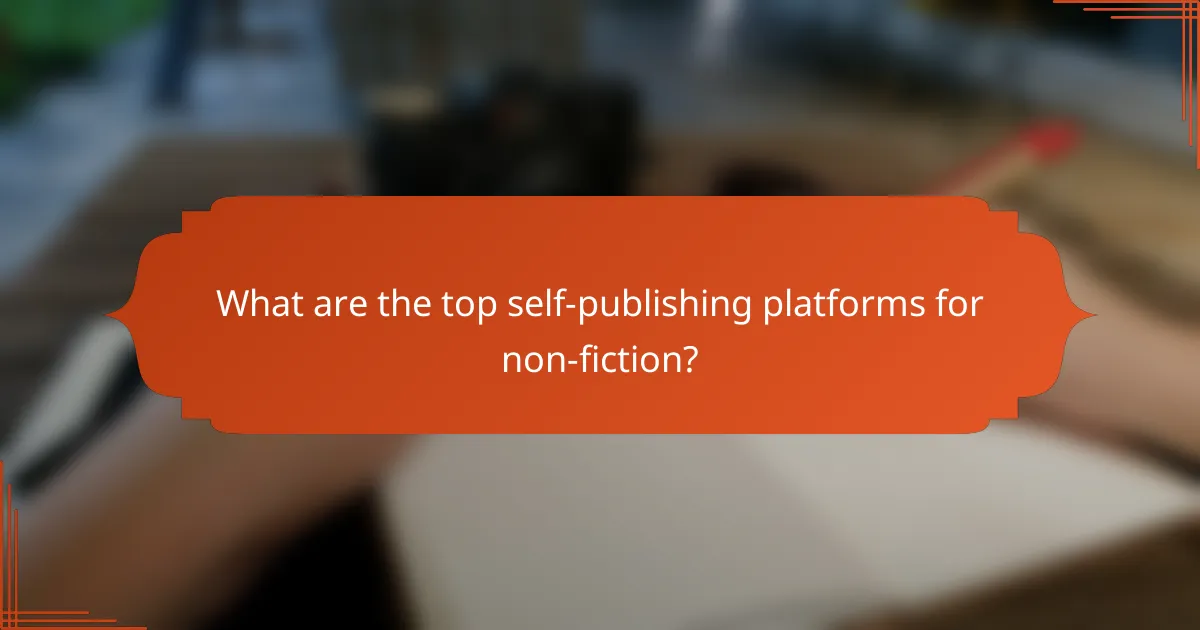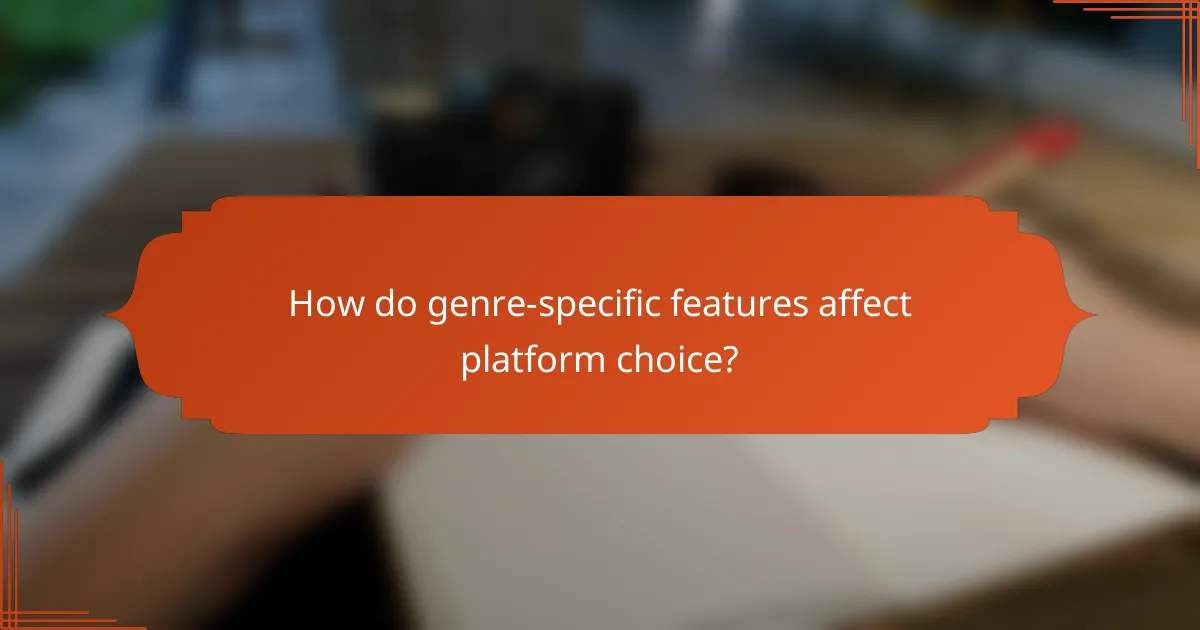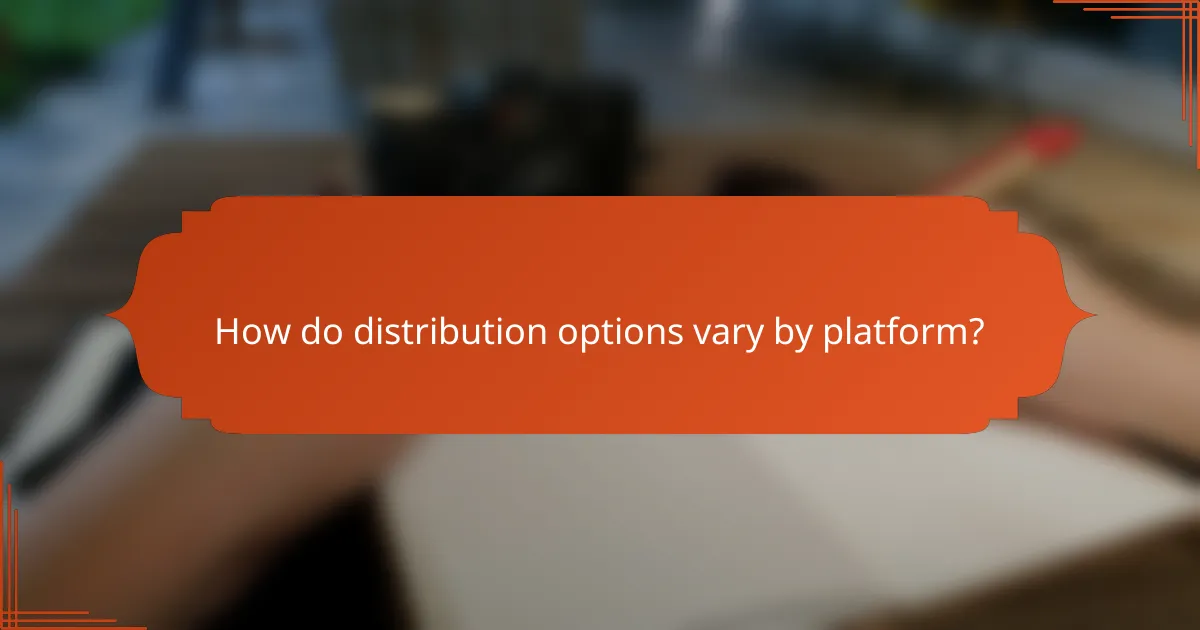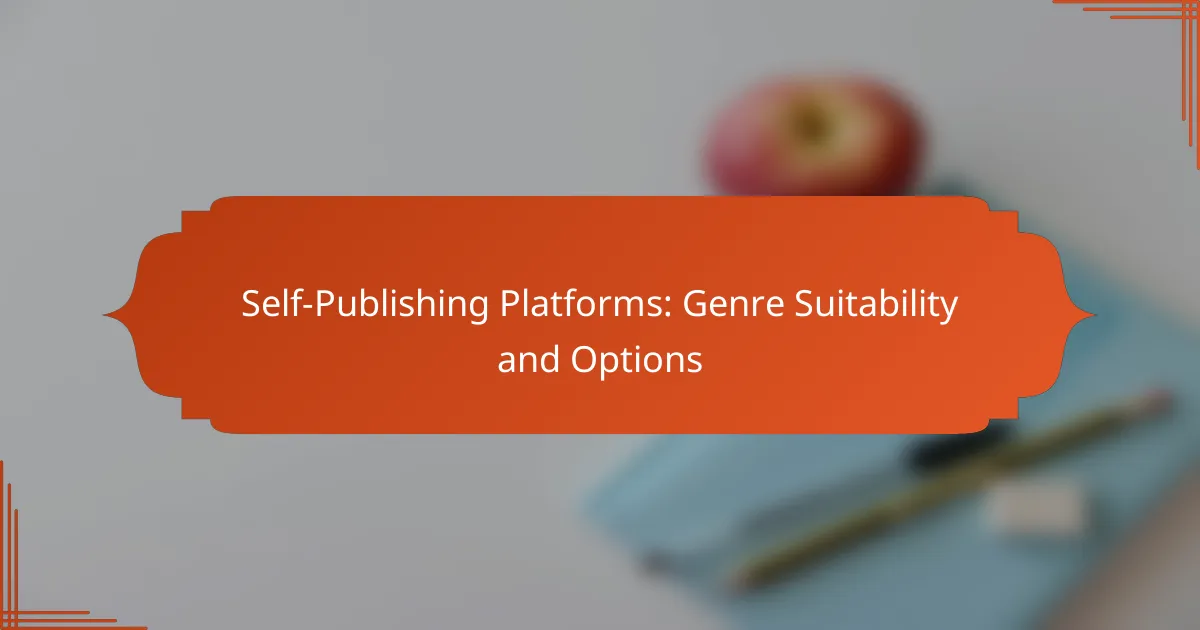Choosing the right self-publishing platform is crucial for authors, as each option caters to different genres and publishing goals. Fiction and non-fiction writers alike can benefit from understanding the unique features, distribution options, and royalty structures offered by platforms like Amazon Kindle Direct Publishing and IngramSpark. By aligning their genre-specific needs with the right tools and marketing opportunities, authors can enhance their chances of success in the competitive publishing landscape.

Which self-publishing platforms are best for fiction authors?
Fiction authors have several self-publishing platforms to choose from, each offering unique features and benefits. The best options often depend on the author’s specific needs, such as distribution reach, royalty rates, and ease of use.
Kobo Writing Life
Kobo Writing Life allows authors to publish their fiction easily and reach a global audience. It offers competitive royalty rates, typically around 70% for books priced between $2.99 and $9.99, making it an attractive option for many writers.
Authors can also take advantage of promotional tools and the ability to set their own prices. Kobo’s integration with local bookstores in various countries can help increase visibility and sales in specific markets.
Amazon Kindle Direct Publishing
Amazon Kindle Direct Publishing (KDP) is one of the most popular platforms for fiction authors, providing access to millions of readers. KDP offers a royalty rate of up to 70% for eBooks priced between $2.99 and $9.99, which can be very lucrative.
Authors can enroll in KDP Select for additional promotional opportunities, such as Kindle Unlimited and Countdown Deals. However, exclusivity is required for KDP Select, which may limit distribution options.
Draft2Digital
Draft2Digital simplifies the self-publishing process by distributing fiction to multiple retailers, including Apple Books, Barnes & Noble, and Kobo. This platform is user-friendly and offers a straightforward royalty structure, typically around 60% after retailer cuts.
One of the key advantages of Draft2Digital is its free formatting tools, which help authors create professional-looking eBooks. Additionally, it provides access to a variety of promotional tools to enhance visibility across different platforms.
Smashwords
Smashwords is another well-known self-publishing platform that offers broad distribution for fiction authors. It allows authors to publish eBooks and distribute them to major retailers and libraries, with royalty rates generally around 60% after retailer fees.
Authors can benefit from Smashwords’ extensive style guide, which helps ensure that their eBooks meet formatting standards. However, the platform may have a steeper learning curve compared to others, so authors should be prepared to invest time in understanding its features.

What are the top self-publishing platforms for non-fiction?
The leading self-publishing platforms for non-fiction include IngramSpark, Amazon Kindle Direct Publishing, and Lulu. Each platform offers unique features and benefits tailored to different publishing needs and goals.
IngramSpark
IngramSpark is a popular choice for non-fiction authors looking to distribute their books widely. It provides access to a vast network of bookstores and libraries, making it easier to reach a broader audience.
Authors can publish both print and eBooks through IngramSpark, but there are setup fees involved, typically ranging from $49 to $99. Consider this investment if you aim for extensive distribution and professional quality.
Amazon Kindle Direct Publishing
Amazon Kindle Direct Publishing (KDP) is one of the most accessible platforms for self-publishing non-fiction. It allows authors to publish eBooks and paperbacks for free, with royalties of up to 70% on eBook sales.
KDP offers tools for formatting and marketing, making it suitable for authors who want to leverage Amazon’s massive customer base. However, competition is fierce, so effective marketing strategies are essential to stand out.
Lulu
Lulu is another viable option for non-fiction authors, particularly for those interested in print-on-demand services. It allows for a variety of formats, including hardcover and photo books, catering to diverse publishing needs.
While Lulu does not charge upfront fees for publishing, authors should consider the cost of printing and distribution. The platform is user-friendly, making it easy to create and publish books, but authors should be prepared to handle their own marketing efforts.

How do genre-specific features affect platform choice?
Genre-specific features significantly influence the choice of self-publishing platforms by catering to the unique needs of different genres. Authors should consider formatting tools, marketing options, and community engagement that align with their genre to maximize their success.
Formatting tools for romance
Romance authors benefit from platforms that offer intuitive formatting tools tailored to their genre’s conventions. Features like customizable templates, easy-to-use cover design tools, and options for including interactive elements can enhance the reading experience.
Many romance readers prefer specific layouts and fonts that evoke emotion. Platforms such as Kindle Direct Publishing (KDP) and Draft2Digital provide genre-specific templates that simplify the formatting process, allowing authors to focus on storytelling.
Marketing options for thrillers
Thriller authors should prioritize platforms that offer robust marketing options to reach their target audience effectively. Features like promotional pricing, targeted advertising, and access to genre-specific reader communities can significantly boost visibility.
Platforms such as Smashwords and KDP offer promotional tools that allow thriller authors to run limited-time discounts or free book promotions. Engaging in genre-specific forums and utilizing social media advertising can also help connect with thriller enthusiasts looking for their next read.

What are the pricing structures of popular self-publishing platforms?
Self-publishing platforms have varying pricing structures that can significantly impact your earnings and expenses. Understanding these costs is essential for authors to choose the right platform based on their financial goals and publishing needs.
Amazon Kindle Direct Publishing fees
Amazon Kindle Direct Publishing (KDP) operates on a royalty-based model, offering authors a choice between 35% and 70% royalties on eBook sales. The 70% royalty option is available for books priced between $2.99 and $9.99, while the 35% option applies to books outside this range.
Additionally, KDP charges a delivery fee based on file size, typically around $0.15 per MB. Authors should consider these fees when pricing their eBooks to maximize profits while remaining competitive.
IngramSpark setup costs
IngramSpark charges a setup fee for publishing both print and eBooks, which can range from $49 to $99 depending on promotions and the type of book. This fee covers the distribution of your book to a wide network of retailers and libraries.
Authors should also be aware of additional costs, such as revisions or changes after the initial setup, which may incur extra charges. It’s crucial to factor these costs into your budget when choosing IngramSpark for self-publishing.
Lulu printing costs
Lulu’s printing costs vary based on book specifications, including size, page count, and binding type. Authors can expect to pay anywhere from a few dollars to over $20 per copy, depending on these factors.
It’s beneficial to use Lulu’s pricing calculator to estimate printing costs before finalizing your project. Keep in mind that authors must also consider shipping fees and potential discounts for bulk orders when planning their budget.

How do distribution options vary by platform?
Distribution options differ significantly among self-publishing platforms, affecting how widely and effectively authors can reach their audience. Some platforms offer extensive global distribution, while others focus on specific markets or exclusive sales channels.
Global reach of IngramSpark
IngramSpark provides authors with access to a vast distribution network, including thousands of retailers, libraries, and online platforms worldwide. This global reach allows authors to sell their books in multiple countries and formats, such as print and eBook.
Authors can expect their titles to be available in major markets like the United States, Canada, the UK, and Australia, as well as in various European and Asian countries. However, authors should consider the setup fees and ongoing costs associated with using IngramSpark, which can vary based on the services selected.
Amazon’s exclusive programs
Amazon offers exclusive programs like Kindle Unlimited (KU) and KDP Select, which can significantly impact distribution. Enrolling in these programs allows authors to reach a large audience through Amazon’s ecosystem but requires exclusivity, meaning the book cannot be available on other platforms during the enrollment period.
While this can lead to increased visibility and potentially higher earnings through page reads, authors should weigh the benefits against the limitations of exclusivity. Many authors find success with these programs, but it’s crucial to assess whether the trade-offs align with their overall publishing strategy.

What are the benefits of using multiple self-publishing platforms?
Using multiple self-publishing platforms allows authors to maximize their visibility and sales potential. By diversifying distribution channels, writers can reach different audiences and leverage unique features offered by each platform.
Wider audience reach
Publishing on various platforms increases the chances of reaching a broader audience. Each platform has its own user base, which can vary significantly in demographics and reading preferences. For instance, Amazon Kindle Direct Publishing (KDP) caters to a vast global market, while platforms like Smashwords and Draft2Digital may attract niche readers.
Consider the genres you write in; some platforms are better suited for specific genres. For example, Wattpad is popular for young adult and romance genres, while platforms like IngramSpark are ideal for authors looking to get into brick-and-mortar bookstores. By selecting the right mix of platforms, you can effectively target your ideal readers.
To optimize your reach, regularly analyze sales data and reader engagement across platforms. This will help you identify which platforms are performing well and where to focus your marketing efforts. Avoid putting all your eggs in one basket; instead, experiment with different platforms to find the best fit for your work.
